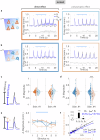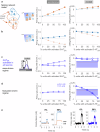Gain control of sensory input across polysynaptic circuitries in mouse visual cortex by a single G protein-coupled receptor type (5-HT2A)
- PMID: 39277631
- PMCID: PMC11401874
- DOI: 10.1038/s41467-024-51861-1
Gain control of sensory input across polysynaptic circuitries in mouse visual cortex by a single G protein-coupled receptor type (5-HT2A)
Abstract
Response gain is a crucial means by which modulatory systems control the impact of sensory input. In the visual cortex, the serotonergic 5-HT2A receptor is key in such modulation. However, due to its expression across different cell types and lack of methods that allow for specific activation, the underlying network mechanisms remain unsolved. Here we optogenetically activate endogenous G protein-coupled receptor (GPCR) signaling of a single receptor subtype in distinct mouse neocortical subpopulations in vivo. We show that photoactivation of the 5-HT2A receptor pathway in pyramidal neurons enhances firing of both excitatory neurons and interneurons, whereas 5-HT2A photoactivation in parvalbumin interneurons produces bidirectional effects. Combined photoactivation in both cell types and cortical network modelling demonstrates a conductance-driven polysynaptic mechanism that controls the gain of visual input without affecting ongoing baseline levels. Our study opens avenues to explore GPCRs neuromodulation and its impact on sensory-driven activity and ongoing neuronal dynamics.
© 2024. The Author(s).
Conflict of interest statement
The authors declare no competing interests.
Figures





Similar articles
-
Reliable Sensory Processing in Mouse Visual Cortex through Cooperative Interactions between Somatostatin and Parvalbumin Interneurons.J Neurosci. 2021 Oct 20;41(42):8761-8778. doi: 10.1523/JNEUROSCI.3176-20.2021. Epub 2021 Sep 7. J Neurosci. 2021. PMID: 34493543 Free PMC article.
-
Cell-Specific Regulation of N-Methyl-D-Aspartate Receptor Maturation by Mecp2 in Cortical Circuits.Biol Psychiatry. 2016 May 1;79(9):746-754. doi: 10.1016/j.biopsych.2015.05.018. Epub 2015 Jun 5. Biol Psychiatry. 2016. PMID: 26185009 Free PMC article.
-
Distinct in vivo dynamics of excitatory synapses onto cortical pyramidal neurons and parvalbumin-positive interneurons.Cell Rep. 2021 Nov 9;37(6):109972. doi: 10.1016/j.celrep.2021.109972. Cell Rep. 2021. PMID: 34758304 Free PMC article.
-
δ-Containing GABAA receptors on parvalbumin interneurons modulate neuronal excitability and network dynamics in the mouse medial prefrontal cortex.J Neurophysiol. 2025 Apr 1;133(4):1003-1013. doi: 10.1152/jn.00495.2024. Epub 2025 Feb 27. J Neurophysiol. 2025. PMID: 40013665 Free PMC article.
-
Serotonergic Suppression of Mouse Prefrontal Circuits Implicated in Task Attention.eNeuro. 2016 Nov 8;3(5):ENEURO.0269-16.2016. doi: 10.1523/ENEURO.0269-16.2016. eCollection 2016 Sep-Oct. eNeuro. 2016. PMID: 27844060 Free PMC article.
Cited by
-
Psychedelic 5-HT2A agonist increases spontaneous and evoked 5-Hz oscillations in visual and retrosplenial cortex.bioRxiv [Preprint]. 2025 Jul 6:2025.07.05.663288. doi: 10.1101/2025.07.05.663288. bioRxiv. 2025. PMID: 40631162 Free PMC article. Preprint.
-
Molecular Pathways Potentially Involved in Hallucinatory Experiences During Sleep Paralysis: The Emerging Role of β-Arrestin-2.Int J Mol Sci. 2025 Jul 26;26(15):7233. doi: 10.3390/ijms26157233. Int J Mol Sci. 2025. PMID: 40806366 Free PMC article. Review.
References
-
- Dayan, P. & Abbott, L. F. Theoretical Neuroscience: Computational and Mathematical Modeling of Neural Systems (Massachusetts Institute of Technology Press, 2001).
Publication types
MeSH terms
Substances
Grants and funding
- Project ID 122679504 - SFB 874/Deutsche Forschungsgemeinschaft (German Research Foundation)
- JA 945/5-1/Deutsche Forschungsgemeinschaft (German Research Foundation)
- Project number 492434978 - GRK 2862/1, Subproject 10/Deutsche Forschungsgemeinschaft (German Research Foundation)
- Project ID 316803389 - SFB 1280 (Subproject A07)/Deutsche Forschungsgemeinschaft (German Research Foundation)
- Project number 492434978 - GRK 2862/1, Subproject 07/Deutsche Forschungsgemeinschaft (German Research Foundation)
- Project ID 316803389 - SFB 1280 (Subproject A21)/Deutsche Forschungsgemeinschaft (German Research Foundation)
- Project number 492434978 - GRK 2862/1, Subproject 05/Deutsche Forschungsgemeinschaft (German Research Foundation)
- MA 5806/2-1/Deutsche Forschungsgemeinschaft (German Research Foundation)
- MA 5806/1-2/Deutsche Forschungsgemeinschaft (German Research Foundation)
- Project ID 122679504 - SFB 874/Deutsche Forschungsgemeinschaft (German Research Foundation)
- Project ID 122679504 - SFB 874/Deutsche Forschungsgemeinschaft (German Research Foundation)
- Project ID 316803389 - SFB 1280 (Subproject A07)/Deutsche Forschungsgemeinschaft (German Research Foundation)
- Project number 492434978 - GRK 2862/1, Subproject 01/Deutsche Forschungsgemeinschaft (German Research Foundation)
- Project number 492434978 - GRK 2862/1, Subproject 09/Deutsche Forschungsgemeinschaft (German Research Foundation)
- ERA-Net Neuron "Horizon 2020", 01EW2104B/Bundesministerium für Bildung und Forschung (Federal Ministry of Education and Research)
LinkOut - more resources
Full Text Sources

